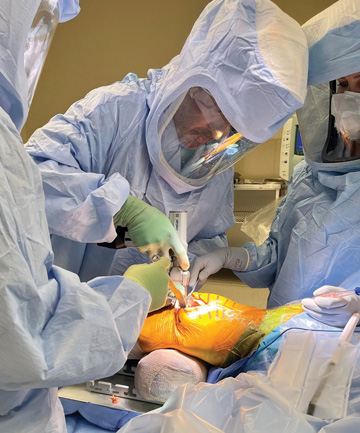Dr. Botero agrees and notes that a double-blinded randomized, controlled trial involving 1,000 robotic knee replacement surgeries and 1,000 knee replacements performed using traditional instrumentation found that each method produced the same
clinical outcomes. Still, Dr. Botero thinks the current orthopedic robotic technology is “fantastic” and produces precise bone cuts.
When patients are actively engaged in their recovery, they tend to have better outcomes.
— Tyler Steven Watters, MD
The ASC in which Dr. Botero operates has an orthopedic robot and the surgeons love using the technology. They acquired it for free from the manufacturer in part of a larger business deal that has the center buying other products from the same
company. To date, a robotic knee replacement costs $1,500 to $1,800 more per case than traditional total knee replacements, so acquiring the robotic console as part of a larger arrangement with the manufacturer might currently be the most
practical option for many surgery centers.
• Handheld navigation. This technology is a practical option for ASCs because it can be used on a case-by-case basis. The devices are a logical replacement for the computer navigation craze that existed in joint replacement
surgery 15 years ago, according to Dr. Watters. They help surgeons improve the accuracy of implant alignment at a reasonable per-case cost without the bulky tower that comes with computer navigation systems. “Many handheld navigation
systems are not cost-prohibitive and they don’t take up a lot of real estate, so they can be used very effectively in an ambulatory setting,” says Dr. Watters.
Dr. Botero thinks the devices can be good options when robotics systems aren’t in a facility’s budget and best used by surgeons who don’t routinely perform knee replacements. While robotic systems are more accurate, the handheld
navigation devices allow for ease of use from a technical standpoint and increase overall surgical accuracy, especially for low-volume physicians. “Studies have shown that these technologies help surgeons who perform 30 to 50 knee replacements
a year to reduce their outliers and performance errors,” says Dr. Botero.
• Remote patient monitoring. Providers can use these platforms to deliver continuous information to patients who own smartwatches or smartphones, and patients can respond with direct feedback. The two-way communication facilitates
better overall care from the patient’s pre-op preparation phase until their recovery is complete.
“This technology is all about patient engagement,” says Dr. Watters. “Patients like it, many have come to expect it, and when patients are actively engaged in their recovery, they tend to have better outcomes. The more connected
and personal the patient experience is, the better.” Reimbursement levels to providers for these services can be relatively low, however, which could be a barrier for use of the platforms when ortho centers operating in a bundled payment
system must closely watch the cost of each line item to remain profitable.
Dr. Botero says surgeons must guard against getting to the point at which they feel like they’re selling technology to the patient, as some insurance plans offer patients the ability to rent a smartwatch or smartphone and an opportunity
to buy them when the rental period ends. It would be best if the technology that tracks outcomes data could be included on the front end in the cost of the bundle of care, says Dr. Botero.
These technological advancements will benefit patient care and their adoption will continue to increase when data shows they improve how knee replacements are performed. “The crux of the role providers play in orthopedics is about improving
clinical outcomes at a lower cost,” says Dr. Botero. “This technology is exciting and is going to continue to improve. Its use will become more widespread when payers and patients see high value in it and prices continue to decrease.”
OSM
.svg?sfvrsn=be606e78_3)

.svg?sfvrsn=56b2f850_5)